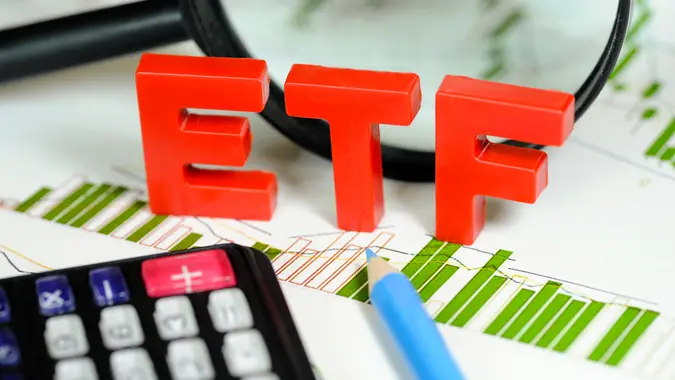Investing in Precious Metals: Benefits, Risks and How to Do It

Commitment to Our Readers
GOBankingRates' editorial team is committed to bringing you unbiased reviews and information. We use data-driven methodologies to evaluate financial products and services - our reviews and ratings are not influenced by advertisers. You can read more about our editorial guidelines and our products and services review methodology.

20 Years
Helping You Live Richer

Reviewed
by Experts

Trusted by
Millions of Readers
Investing in precious metals has always been a reliable way to diversify portfolios and safeguard against economic uncertainty. But when it comes to choosing between gold vs silver investment, which metal offers better potential for returns and stability? Both have their pros and cons, so understanding their unique characteristics is key to making an informed decision.
In this guide, we’ll break down the differences, explore the benefits and risks, and help you figure out which option aligns best with your financial goals.
Key Differences Between Gold and Silver
Before diving into the benefits and risks of each metal, let’s look at some essential differences between gold and silver that could shape your investment strategy.
Value and Price
- Gold: Known for its higher price point, gold is a symbol of wealth and security. It’s less affected by industrial demand, making it a go-to investment during economic downturns.
- Silver: Silver is more affordable and accessible, especially for new investors. However, it’s more prone to price swings due to its significant role in various industries.
Supply and Demand
- Gold: Demand primarily comes from jewelry and investment purposes. Supply is relatively stable, thanks to consistent mining and recycling.
- Silver: Silver sees demand from both investors and industries, such as electronics and solar panels. This dual demand can make silver prices more sensitive to economic trends.
Benefits of Investing in Gold
Gold has long been favored for its stability and long-term value. Here’s why it might be a smart choice for your investment portfolio.
- Inflation Hedge: Gold retains value during periods of high inflation. As currency values drop, gold prices often rise.
- Global Recognition: Gold is universally valued, making it easy to buy, sell or trade around the world.
- Safe Haven: During times of market uncertainty, gold acts as a stabilizer, helping to protect your wealth.
- Liquidity: Gold is easy to convert into cash, ensuring flexibility when you need it.
Benefits of Investing in Silver
Silver also has unique strengths, particularly for those looking for accessible and high-growth potential investments.
- Affordability: Silver’s lower price makes it a great entry point for new investors.
- Industrial Demand: Silver is essential for industries like electronics, solar energy and healthcare. Growing sectors can drive its value higher.
- Higher Volatility for Higher Gains: Silver’s price swings can lead to substantial returns during favorable market conditions.
- Diversification: Adding silver to your portfolio alongside other assets can help balance risk.
Risks of Investing in Gold
Despite its benefits, gold isn’t without risks. Here are a few to consider:
- Slower Growth: Gold’s stability means it may not offer quick, high returns.
- Higher Initial Investment: Gold is expensive per ounce, requiring a larger upfront cost.
- Market Sensitivity: Global events and shifts in investor sentiment can still affect gold prices.
Risks of Investing in Silver
Silver, while affordable, comes with its own set of challenges:
- Price Volatility: Silver prices can swing dramatically, reacting to the market and industrial changes.
- Storage Concerns: You’ll need more space to store significant amounts of silver due to its lower value per ounce.
- Economic Sensitivity: Silver’s industrial demand makes it more vulnerable to economic downturns.
How to Invest in Gold and Silver
Thinking about adding precious metals to your portfolio? Here are the most common ways to invest in gold and silver.
Gold Investment Options
- Physical Gold: Buy gold coins, bars, or jewelry for direct ownership.
- Gold ETFs: Exchange-traded funds track gold prices without the need to store physical assets.
- Gold Mining Stocks: Invest in companies that mine gold. This can offer high returns but also carries stock market risk.
- Mutual Funds: Some funds focus on precious metals, providing diversified exposure.
Silver Investment Options
- Physical Silver: Purchase coins, bars, or jewelry to hold and store.
- Silver ETFs: These funds offer an easy, storage-free way to invest in silver.
- Silver Mining Stocks: Invest in companies that specialize in silver production.
- Mutual Funds: Some funds focus on silver and other precious metals.
Gold vs Silver: Which is the Better Investment for You?
Ultimately, choosing between gold and silver depends on your financial goals and risk appetite.
- Seeking Stability: Gold is often the safer bet, retaining value over the long term.
- Chasing Growth: If you’re comfortable with more risk, silver could offer higher returns.
- Looking for Balance: Diversifying with both metals can help manage risk while capturing growth opportunities.
Comparison Table: Gold vs Silver Investment
| Factor | Gold | Silver |
|---|---|---|
| Price | Higher, more stable | Lower, more volatile |
| Industrial Use | Limited | Extensive (electronics, energy) |
| Volatility | Less volatile | More volatile |
| Affordability | Higher entry cost | More affordable for new investors |
| Storage | Requires less space | Needs more storage for the same value |
Final Take to GO
Deciding whether to invest in gold or silver depends on your investment strategy and risk tolerance. Gold offers stability and security, while silver presents more potential for growth due to its industrial uses and price volatility.
If you’re unsure, consider diversifying with both. This way, you can balance the safety of gold with the growth potential of silver. Ready to start investing? Research your options, set your goals, and take the first step toward building a stronger, more diverse portfolio.
FAQ
Although the basic idea behind investing in precious metals can be simple to understand, there are still many common questions surrounding them, in part because there are so many different kinds. Here are the answers to some of the most frequently asked questions regarding getting started investing in precious metals:- Which is a safer investment, gold or silver?
- Gold is generally considered safer due to its consistent value retention and lower volatility. Silver has greater growth potential but comes with higher risk.
- Can I make money faster with silver than with gold?
- Potentially, yes. Silver’s price can rise quickly during favorable market conditions. However, it can also drop just as fast.
- How do I buy gold or silver for investment?
- You can purchase physical metals from reputable dealers or invest through ETFs, mining stocks or mutual funds.
- Is it better to invest in gold or silver during economic downturns?
- Gold tends to perform better during economic downturns due to its stability. Silver can be more volatile but also presents opportunities if industrial demand remains strong.
Information is accurate as of March 14, 2025.
Editorial Note: This content is not provided by any entity covered in this article. Any opinions, analyses, reviews, ratings or recommendations expressed in this article are those of the author alone and have not been reviewed, approved or otherwise endorsed by any entity named in this article.
Our in-house research team and on-site financial experts work together to create content that’s accurate, impartial, and up to date. We fact-check every single statistic, quote and fact using trusted primary resources to make sure the information we provide is correct. You can learn more about GOBankingRates’ processes and standards in our editorial policy.
- Google Finance "Gold prices"
- Google Finance "Silver prices"
- Investing.com "Gold prices steady ahead of US inflation data; Trump tariffs in focus"
- Reuters "Gold scales record high, sprints towards $3,000 milestone"
- ETF Database "Gold ETFs"
- ETF Database "Silver ETFs"
 Written by
Written by  Edited by
Edited by 

























